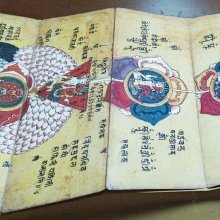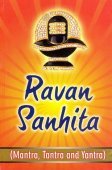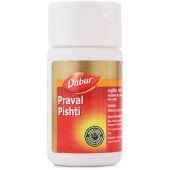Tantra, Tantrā, Tamtra, Tantrism: 34 definitions
Introduction:
Tantra means something in Buddhism, Pali, Hinduism, Sanskrit, Jainism, Prakrit, the history of ancient India, Marathi, Hindi. If you want to know the exact meaning, history, etymology or English translation of this term then check out the descriptions on this page. Add your comment or reference to a book if you want to contribute to this summary article.
Images (photo gallery)
(+113 more images available)
In Hinduism
Purana and Itihasa (epic history)
Source: archive.org: Shiva Purana - English TranslationTantra (तन्त्र) refers to a type of ritualistic worship, as mentioned in the Śivapurāṇa 1.10. The rites of worship are performed in accompaniment with Tantra, Yantra and Mantra appliances. Yantra is a mystical diagram possessed of occult powers. Tantra is a ritual, the chief peculiarity of which is the worship of the female energy of Śiva. personified in the person of his Śakti. This special energy, the Śakti of Śiva is concerned with sexual intercourse and magic power. Mantra is a magical formula.
Source: Cologne Digital Sanskrit Dictionaries: The Purana IndexTantra (तन्त्र).—Āgama śāstra in which yogins were learned;1 prescribes rules for the worship of Hari;2 known in Dvāpara yuga,3 deals with the vibhūtis of Hari.4
- 1) Bhāgavata-purāṇa I. 3. 8; IV. 24. 62; Vāyu-purāṇa 104. 86.
- 2) Bhāgavata-purāṇa XI. 3. 47.
- 3) Ib. XI. 5. 28 and 31; 27. 26.
- 4) Bhāgavata-purāṇa XII. 11. 4 and 20.

The Purana (पुराण, purāṇas) refers to Sanskrit literature preserving ancient India’s vast cultural history, including historical legends, religious ceremonies, various arts and sciences. The eighteen mahapuranas total over 400,000 shlokas (metrical couplets) and date to at least several centuries BCE.
Vyakarana (Sanskrit grammar)
Source: archive.org: Bhartrihari's VakyapadiyaTantra (तन्त्र) means the power of a word, uttered only once to convey more than one thing, according to the 5th century Vākyapadīya: a Sanskrit grammatical treatise dealing with the philosophy of language written by Bhartṛhari.
Source: Wikisource: A dictionary of Sanskrit grammarTantra (तन्त्र).—A word frequently used in the Mahabhasya in the sense of 'intended ' or विवक्षित (vivakṣita). The word is used always in the neuter gender like प्रमाणम् (pramāṇam); cf. तन्त्रं तरनिर्देशः (tantraṃ taranirdeśaḥ) M. Bh. on P. I. 2.33, II. 2.34, नात्र निर्दे-शस्तन्त्रम् (nātra nirde-śastantram) On P. I. 2.39, III.3.38, III. 4.21,IV.1.92 etc. The word is also explained in the sense of 'impor. tant'.

Vyakarana (व्याकरण, vyākaraṇa) refers to Sanskrit grammar and represents one of the six additional sciences (vedanga) to be studied along with the Vedas. Vyakarana concerns itself with the rules of Sanskrit grammar and linguistic analysis in order to establish the correct context of words and sentences.
Jyotisha (astronomy and astrology)
Source: Wikibooks (hi): Sanskrit Technical TermsTantra (तन्त्र).—A type of astronomical treatise. Note: Tantra is a Sanskrit technical term used in ancient Indian sciences such as Astronomy, Mathematics and Geometry.

Jyotisha (ज्योतिष, jyotiṣa or jyotish) refers to ‘astronomy’ or “Vedic astrology” and represents the fifth of the six Vedangas (additional sciences to be studied along with the Vedas). Jyotisha concerns itself with the study and prediction of the movements of celestial bodies, in order to calculate the auspicious time for rituals and ceremonies.
Ayurveda (science of life)
Source: archive.org: Vagbhata’s Ashtanga Hridaya Samhita (first 5 chapters)Tantra (तन्त्र) refers to a “manual”, mentioned in verse 3.38 of the Aṣṭāṅgahṛdayasaṃhitā (Sūtrasthāna) by Vāgbhaṭa.—Accordingly, “[...] And on a moonbeam-flooded palace-roof garden (one shall fix) at night one’s bedstead. From him whose mind is at ease, (who is) moist with sandal (and) adorned with garlands, by whom the manual of love has been put aside [viz., nivṛtta-kāma-tantra], (and) whose clothes are very thin and fine”.
Note: nivṛtta-kāma-tantra (“by whom the manual of love has been put aside”) has been interchanged with susūkṣmatanuvāsas and converted into the main clause: ’dod-pai rgyun-las ldog-par bya—“one shall turn away from the stream of love”. Although fitting the context, there can be no doubt whatever that rgyun “stream” is simply corrupt for rgyud, the proper equivalent of tantra “manual”.—ldog-pa has been replaced in CD by the synonymous dog-pa.
Source: gurumukhi.ru: Ayurveda glossary of terms1) Tantra (तन्त्र):—System or doctrines, specially signifies system of ayurvead
2) [tantram] Body as a whole, different systems of body

Āyurveda (आयुर्वेद, ayurveda) is a branch of Indian science dealing with medicine, herbalism, taxology, anatomy, surgery, alchemy and related topics. Traditional practice of Āyurveda in ancient India dates back to at least the first millenium BC. Literature is commonly written in Sanskrit using various poetic metres.
Shaktism (Shakta philosophy)
Source: Google Books: ManthanabhairavatantramTantra (तन्त्र) refers to a category of texts.—The format in which all Tantras are set is a dialogue between two beings, who are usually the god and the goddess. Prior to the emergence of the Kubjikā Tantras, the main speaker and teacher in the earlier Bhairavatantras and Siddhāntāgamas is Śiva who answers the goddess’s questions. The teacher in the later Kaula Tantras is often the goddess. The later Tantras distinguish these two types of scripture by referring to the former as Āgama and the latter as Nigama. This nomenclature is totally unknown to the Kubjikā Tantras.
Tantra is generated by Sadāśiva, according to the Svacchandabhairavatantra 8.31 (quoted in the commentary of Vijñānabhairava 7ab):—“The god Sadāśiva, established on the plane of teacher and disciple, (generated) the Tantra by himself by means of questions and answers (brought about) by the split in the (one) foundation (of the deity who questions and the one who responds)”.
Note: Heilijgers-Seelen (in Kubjikāmatatantra verse 16.29cd) does not translate the word ‘tantraṃ’; instead she treats it simply as a synonym of ‘artham’. The noun artham (normally masculine neuter) may be translated as ‘doctrine’. The word ‘tantra’ is not normally understood this way.

Shakta (शाक्त, śākta) or Shaktism (śāktism) represents a tradition of Hinduism where the Goddess (Devi) is revered and worshipped. Shakta literature includes a range of scriptures, including various Agamas and Tantras, although its roots may be traced back to the Vedas.
Nirukta (Sanskrit etymology)
Source: Shodhganga: Kasyapa Samhita—Text on Visha Chikitsa (nirukta)1) Tantra (तन्त्र) (according to some scholars) means “spreading out of the cosmic energy (in the person who practices it)”.—The universal energy, latent in the individual, comes forth from his body when activated by his rigorous practice of Yoga. The term ‘tantra’ is derived from two roots, ‘tan’ and ‘tra’. ‘Tan’ means extending or elaborate, explaining the knowledge of the tenets discussed in the Vedas; ‘tra’ means ‘protect’. The two together point to a system which provides the common man with the means of knowing reality and also protecting him from the various hassles in life says that Kāmikāgama I.29. [...] Note: Āgama is also known variously as Tantra and Saṃhitā.
2) Tantra (तन्त्र) is derived from the root ‘tan’ (to spread), ‘tattri’ or ‘tantri’ (to explain); it therefore means scientific discussion on any subject.—Tantra could mean the essence of a thing. It was deemed as the essence of Sastric wisdom. It could mean a set of doctrines, practices, mystic syllables, metaphysical enquiry and the like.—Note: Mr. H.P. Śāstri (Notices of Sanskrit Manuscripts) states that tantra means ‘shortening’, i.e. it attempts to reduce to short algebraic forms, mantras which could otherwise be very lengthy. The process of recording mantras in the form of Yantra and its application is what is meant by tantra in the Indian tradition.
Nirukta (निरुक्त) or “etymology” refers to the linguistic analysis of the Sanskrit language. This branch studies the interpretation of common and ancient words and explains them in their proper context. Nirukta is one of the six additional sciences (vedanga) to be studied along with the Vedas.
Pancaratra (worship of Nārāyaṇa)
Source: Shodhganga: Kasyapa Samhita—Text on Visha Chikitsa (p)Tantra (तन्त्र) could mean a set of doctrines, practices, mystic syllables, metaphysical enquiry and the like.—The followers of the Tantra-śāstra contend that, in the age of Kali, when humanity is bogged down with the unbearable baggage of adharma and asatya, it is impossible to perform the rigorous rituals and austerities prescribed in the Vedic tradition. People have little time to indulge in such rigorous spiritual pursuits as most of it is diverted towards materialistic, day-to-day needs. It is here that the Tantra or Āgamaśāstra steps in and provides practical guidance to mankind to achieve the puruṣārthas of dharma, artha, kāma and mokṣa.
The Tantra-śāstra has some distinct features which have a wider appeal to the masses when compared with the Vedic rituals. The foremost is its catholicity of outlook which welcomes anyone and everyone into its fold, irrespective of caste, birth, age and sex. Women are revered and even exalted as ‘strīguru’. Second, there is no need here for preparatory rigorous training to judge a person’s fitness for initiation as prescribed in the Vedic tradition. Few have the kind of mental purity, detachment and so on, which are but the outcome of strenuous study and penance. The Tantra Śāstra does not pitch itself to high exacting standards. It is fully aware of the unchangeable truth that all humans are not made of the same physical and mental capacity.

Pancaratra (पाञ्चरात्र, pāñcarātra) represents a tradition of Hinduism where Narayana is revered and worshipped. Closeley related to Vaishnavism, the Pancaratra literature includes various Agamas and tantras incorporating many Vaishnava philosophies.
General definition (in Hinduism)
Source: Google Books: Tantra, Its Mystic and Scientific BasisTantra (तन्त्र) is a process of Sādhanā which relieves one from the fetters of crudeness (ta). Thus, Tantra is an intuitional science which stands for the progressive realization of the Divine. It liberates one from the cimmerian darkness and leads unto the divine effulgence. It is a path of Salvation. It is a science of the soul. The authoritative definition of Tantra is, that which brings emancipation from the bondage of Māyā (tatraya ayat tārayet yastu sa tantra parikirtitaḥ).
Source: Institute of Sri Ramchandra Consciousness: A Handbook of Hindu Religion: LiteratureTantra (तन्त्र):—The method of pleasing the Gods in an easy manner and thereby attaining advantages in this and the next world of svarga and finally mokṣa by following the Yoga is described in the Tantras. Tantras are practical treatises of religion. By means of worship of arca or yantras by means of repetition of mantras or mystic utterances, by means of upāsanas, they provide courses for developing the hidden power in man leading to the realization of God. These are also used for the attainment of worldly desires.
Source: Hindupedia: The Hindu EncyclopediaTantra (तन्त्र) refers to otne of the three parts of the agamas. Tantra is the entire philosophy and procedure of worship. The Tantra expounding Śrī-Vidyā is called Śrī-Vidyā Tantra, and is found in many Śāktā texts like Prapañcasāra and Rudrayāmala.
Source: Shodhganga: Iconographical representations of Śiva (h)Tantra (तन्त्र).—That which elaborately explains the meanings that are dealt in holy texts and protects the people in the world so, they are called Tantra. The word Tantra has two roots they are tan and tra, the former gives the meaning tan vistāre which means to expand and tra pālane to defend from. The holy texts i.e. Āgamas are capable of explaining the (hidden) meanings explicitly and protect (from all aspects) the peoples to understand and follow it.
In Buddhism
Tibetan Buddhism (Vajrayana or tantric Buddhism)
Source: archive.org: The Indian Buddhist IconographyTantra (तन्त्र) refers to sciences dealing with psychic matters, and give directions for a variety of psychic exercises. It therefore stands to reason that the Tantra is a science or a Vidyā requiring competent preceptors and efficient disciples. Like all other sciences the Tantra is not also open to all and the sundry, but only for those who are initiated into the mysteries of the science, and are competent to follow the prescribed practices with patience and zeal. These are the right type of disciples for Tantric practices, and may be called the Adhikārins or rightful persons. In many Tantric works long chapters are devoted to the qualifications of the preceptors and disciples and there are also rules for their respective competence to give or receive initiation.

Tibetan Buddhism includes schools such as Nyingma, Kadampa, Kagyu and Gelug. Their primary canon of literature is divided in two broad categories: The Kangyur, which consists of Buddha’s words, and the Tengyur, which includes commentaries from various sources. Esotericism and tantra techniques (vajrayāna) are collected indepently.
General definition (in Buddhism)
Source: Wisdom Library: BuddhismTantra:—Secret teachings based on later Hindu practices.
In Jainism
Jain philosophy
Source: archive.org: Anekanta Jaya Pataka of Haribhadra SuriTantra (तन्त्र) refers to a “system of philosophy” (e.g., Jainism), as occurring in the Anekāntajayapatākā-prakaraṇa, a Śvetāmbara Jain philosophical work written by Haribhadra Sūri.—[Cf. Vol. I, P. 74, l 25]—‘Tantra’ is a homonym Here it is used in the sense of a ‘system of philosophy’—Jainism. The word ‘tantrāntarīya’ occurs in the Bhāṣya (pp 121, 232 and 354) on Tattvārthasūtra. Gandhahastin Siddhasena Gaṇī explains it as “???” on p 121. The word ‘svatantra’ meaning ‘Jainism’ occurs on p 175,1 19 and ‘tantra’ in Vol II, p 181, l. 4 and p 238, l. 26 On p 101, l. 19 we come across the phrase “svatantrarājakrīḍāprakhyam”.
-
India history and geography
Source: Cologne Digital Sanskrit Dictionaries: Indian Epigraphical GlossaryTantra.—(ASLV), army, government; cf. Tantrin in South Indian inscriptions. (SITI), army, mainly the infantry; cf. Tantrin in South Indian inscriptions. (CII 4), explained as ‘Home Affairs’. (LP), cf. tantre nirūpita, ‘officially sent’. (HIQ, Vol. XXXIV, p. 277), cf. Tantra-adhikārin, ‘officer in charge of administration’, in the Bhāturiyā inscription of Rājyapāla. In this case, a person was at first a Mantrin, then a Saciva and finally a Tantra-adhikārin. Cf. Sarva-tantra-adhikṛta (EI 24), superintendent of all departments. Note: tantra is defined in the “Indian epigraphical glossary” as it can be found on ancient inscriptions commonly written in Sanskrit, Prakrit or Dravidian languages.
Source: Yale Journal of Music & Religion: Ritual Music in Contemporary Brahmanical Tantric Temples of KeralaTantra generally refers to a pan-Asian religious phenomenon spread over numerous centuries and including a wide number of sects having different and even opposing philosophical and theological approaches. The human body, in Tantra, is a representation of an emanationist cosmology that proceeds as a movement from the pure to the impure and from the subtle to the gross. In other words, the structure of the body is a reflection of the hierarchical structure of the cosmos, and is itself thought to be an emanation from a higher level.—(Cf. Gavin Flood, The Tantric Body)—In this perspective, salvation is conceived as a pathway back through the levels of the cosmos from the impure to the pure to its source, and the human body, which is an icon of the cosmos, is conceived as the path itself.

The history of India traces the identification of countries, villages, towns and other regions of India, as well as mythology, zoology, royal dynasties, rulers, tribes, local festivities and traditions and regional languages. Ancient India enjoyed religious freedom and encourages the path of Dharma, a concept common to Buddhism, Hinduism, and Jainism.
Languages of India and abroad
Marathi-English dictionary
Source: DDSA: The Molesworth Marathi and English Dictionarytantra (तंत्र).—n (S) A thread; any string or rope or wire; a chord of a musical instrument; and hence, a royal retinue; a cortége or court; a suite or train: also subservience, service, subjection, dependence. But the significations following are more popular. A course or way; a line of conduct; a path of procedure. Ex. āmacēṃ tantra nirāḷēṃ tumacēṃ tantra nirāḷēṃ. 2 A cause common to two or more effects; an instrument or a means producing a plurality of results;--as a speech involving answers to several questions; efforts or labor accomplishing different objects; one stone killing two birds. Ex. pānēṃ kāṃ saḍalīṃ ghōḍā kāṃ aḍalā vidyā kāṃ visara- lāṃ? Answer. phēra nāhīṃ; prapañca āṇi īśvarabhajana tantrā- nēṃ hōta nāhīṃ; mī kāśīsa gēlōṃ āṇi udīma āṇi yātrā tantrānēṃ dōnhī jhālīṃ. 3 The line of obedience or dependence. Ex. rājācē tantrānēṃ pradhānānēṃ cālāvēṃ. 4 The mere manual acts in a religious ceremony; i. e. the acts without a mantra. 5 A religious treatise teaching peculiar formulæ, rites for worship &c. 6 A branch of the Vedas,--that which teaches mantras. 7 A section of the Jyotishshastra, --that in which are calculated the positions and movements of the planets.
Source: DDSA: The Aryabhusan school dictionary, Marathi-Englishtantra (तंत्र).—n A thread. A course. The line of obedience. A branch of the Vedas. The acts without a mantra.
Marathi is an Indo-European language having over 70 million native speakers people in (predominantly) Maharashtra India. Marathi, like many other Indo-Aryan languages, evolved from early forms of Prakrit, which itself is a subset of Sanskrit, one of the most ancient languages of the world.
Sanskrit dictionary
Source: DDSA: The practical Sanskrit-English dictionaryTantra (तन्त्र).—1 A loom; तदाऽपश्यत् स्त्रियौ तन्त्रे अधिरोप्य सुवेमे पटं वयन्त्यौ (tadā'paśyat striyau tantre adhiropya suveme paṭaṃ vayantyau) Mahābhārata (Bombay) 1.3.144.
2) A thread.
3) The warp or threads extended lengthwise in a loom; सिरीस्तन्त्रं तन्वते अप्रजज्ञयः (sirīstantraṃ tanvate aprajajñayaḥ) Ṛgveda 1.71.9.
4) Posterity.
5) An uninterrupted series.
6) The regular order of ceremonies and rites, system, framework, ritual; कर्मणां युगपद्भावस्तन्त्र (karmaṇāṃ yugapadbhāvastantra) Kāty.; अशक्यं हि उत्तरं तन्त्रं कर्तुम् (aśakyaṃ hi uttaraṃ tantraṃ kartum) | ŚB. on MS.1.2.57.
7) Main point; प्रकर्षतन्त्रा हि रणे जयश्रीः (prakarṣatantrā hi raṇe jayaśrīḥ) Kirātārjunīya 3.17.
8) Principal doctrine, rule, theory, science; विधिनोपचरेद्देवं तन्त्रोक्तेन च केशवम् (vidhinopacareddevaṃ tantroktena ca keśavam) Bhāg. 11.3.47; जितमनसिजतन्त्रविचारम् (jitamanasijatantravicāram) Gītagovinda 2.
9) Subservience, dependence; as in स्वतन्त्र, परतन्त्र (svatantra, paratantra); दैवतन्त्रं दुःखम् (daivatantraṃ duḥkham) Daśakumāracarita 5.
1) A scientific work.
11) a chapter, section, as of a work; तन्त्रैः पञ्चभिरेतच्चकार सुमनोहरं शास्त्रम् (tantraiḥ pañcabhiretaccakāra sumanoharaṃ śāstram) Pañcatantra (Bombay) 1.
12) A religious treatise teaching magical and mystical formularies for the worship of the deities or the attainment of superhuman power; Kathāsaritsāgara 23.63; Bṛ. S.16.19.
13) The cause of more than one effect.
14) A spell.
15) A chief remedy of charm; जानन्ति तन्त्रयुक्तिम् (jānanti tantrayuktim) Manusmṛti 2.1.
16) A drug, medicament.
17) An oath, ordeal.
18) Raiment.
19) The right way of doing anything.
2) Royal retinue, train, court.
21) A realm, country, authority.
22) (a) Government, ruling, administration; लोकतन्त्रविधानम् (lokatantravidhānam) Mahābhārata (Bombay) 3.162.1;13.63.5; लोकतन्त्राधिकारः (lokatantrādhikāraḥ) Ś.5. (b) Arrangement or machinery of government; सर्वमेव तन्त्रमाकुली- भूतम् (sarvameva tantramākulī- bhūtam) Mu.1;2.1.
23) An army; पराजिताः फल्गुतन्त्रैः (parājitāḥ phalgutantraiḥ) Bhāgavata 1.54.15.
24) A heap, multitude.
25) A house.
26) Decoration.
27) Wealth.
28) Happiness.
29) Model.
3) Supporting a family; Mv.2.17.
31) Providing for the security and prosperity of a kingdom; Mahābhārata (Bombay) 1.13. 26.
32) A group of acts or subsidiaries common to several प्रधानकर्म (pradhānakarma)s or things; यत् सकृत्कृतं बहूनामुपकरोति तत् तन्त्रमित्युच्यते । तथा बहूनां ब्राह्मणानां मध्ये कृतः प्रदीपः (yat sakṛtkṛtaṃ bahūnāmupakaroti tat tantramityucyate | tathā bahūnāṃ brāhmaṇānāṃ madhye kṛtaḥ pradīpaḥ) ŚB. on MS.11.1.1; तन्त्रं साधारणो धर्मग्रामः (tantraṃ sādhāraṇo dharmagrāmaḥ) | ŚB. on MS.12.1.1. (Opp. āvāpaḥ)
33) The order of the world; यतः प्रवर्तते तन्त्रं यत्र च प्रतितिष्ठति (yataḥ pravartate tantraṃ yatra ca pratitiṣṭhati) Mahābhārata (Bombay) 14.2.14.
34) A detail (matter or thing) which is subservient to (i. e. serves the purpose of) several things simultaneously; साधारणं भवेत् तन्त्रम् (sādhāraṇaṃ bhavet tantram) ŚB. on MS.12.1.1.
Derivable forms: tantram (तन्त्रम्).
--- OR ---
Tantrā (तन्त्रा).—Sleepiness; cf. तन्द्रा (tandrā).
Source: Cologne Digital Sanskrit Dictionaries: Shabda-Sagara Sanskrit-English DictionaryTantra (तन्त्र).—mfn.
(-ntraḥ-ntrā-ntraṃ) Dependant, subsarvient. m.
(-ntraḥ) A weaver. f. (-ntrī) 1. Any string or rope. 2. The wire or string of a lute. 3. Any tubular vessel of the body. 4. A plant, (Menispermum glabrum:) see gūḍucī. 5. The name of a river. 6. A young woman. n.
(-ntraṃ) 1. A Tantra, a religious treatise teaching peculiar and mystical formulæ and rites for the worship of the deities, or the attainment of superhuman power: it is mostly in the form of a dialogue between Siva and Durga, who are the peculiar gods of the Tantrikas: there is a great number of these works, and their authority, in many parts of India, seems to have, in a great measure, superseded that of the Vedas: according to one account, a Tantra comprises five subjects, the creation and destruction of the world, the worship of the gods, the attainment of all objects, magical rites for the acquirement of six (superhuman) faculties, and four modes of union with spirit by meditation; a variety of subjects are, however, introduced many of them, whilst some are limited to a single topic, as the mode of breathing in certain rites, the language of birds, beasts, &c. 2. A branch of the Vedas, that which teaches Mantra or mystical and magical formulæ. 3. Demonstration, clear and right conclusion. 4. Raiment, vesture. 5. A medicament, a drug. 6. A principal medicament, or perhaps a charm considered as producing medicinal effects. 7. Providing for a family. 8. A cause, a motive. 9. Cause common to two or more results; the instruments or means of more than one effect. 10. Necessary or indispensable act or provision; the right way of doing any thing. 11. Chief, principal. 12. A royal retinue, a court, a train. 13. An army. 14. A royal property: that of providing for the security and prosperity of the kingdom. 15. A realm, a country. 16. A thread, 17. Subservience, service, dependance. 18. Oath or ordeal. 19. Decorations, hanging with trophies, garlands, &c. 20. Heap, multitude. 21. Wealth. 22. A house. 23. An implement or weaving a loom. 24. Happiness, felicity. E. tana to spread or extend, affix ṣṭran; or tatri to spread, to support a family, &c. affix ka, fem. affix ṅīp; or tantra with ī Unadi aff.
--- OR ---
Tāntra (तान्त्र).—mfn.
(-ntraḥ-ntrī-ntraṃ) 1. Stringed, having wires or strings, (as a musical instrument.) 2. Relating to the Tantras, &c. E. tantra, and aṇ aff.
Source: Cologne Digital Sanskrit Dictionaries: Benfey Sanskrit-English DictionaryTantra (तन्त्र).—[tan + tra], I. n. 1. A warp, Mahābhārata 1, 806. 2. A series, propagation, offspring, Mahābhārata 13, 2567. 3. A system, a totality, [Bhāgavata-Purāṇa, (ed. Burnouf.)] 3, 144; order, Mahābhārata 1, 4171. 4. The order of ceremonies, a ritual, [Bhāgavata-Purāṇa, (ed. Burnouf.)] 2, 6, 25. 5. Necessary or indispensable act, or provision, [Rāmāyaṇa] 3, 61, 28; 2, 7, 19 Gorr. 6. Main point, Mahābhārata 14, 612; essence, [Bhāgavata-Purāṇa, (ed. Burnouf.)] 3, 30. 10; principle, Mahābhārata 12, 7663. 7. Rule. [Yājñavalkya, (ed. Stenzler.)] 1, 228. 8. Science, [Bhāgavata-Purāṇa, (ed. Burnouf.)] 3, 7, 30. 9. A religious or scientific work, a literary work in general, [Bhāgavata-Purāṇa, (ed. Burnouf.)] 1, 3, 8; 9, 21, 6; [Rāmāyaṇa] 4, 17, 15. 10. Part of a work, [Suśruta] 1, 3, 13; [Pañcatantra] pr. [distich] 3. 11. A class of mystical and magical writings, treating particularly of spells, charms, etc. 12. Spell, [Pañcatantra] i. [distich] 80. 13. An army. Ii. f. rī (nom. sing. tantrīs), 1. A string, [Mānavadharmaśāstra] 4, 38; of a bow, Mahābhārata 12, 4375; of a musical instrument, [Meghadūta, (ed. Gildemeister.)] 84. 2. Music of a string-instrument, [Bhāgavata-Purāṇa, (ed. Burnouf.)] 1, 6, 39.
--- OR ---
Tāntra (तान्त्र).—i. e. tantrī + a, n. Instrumental music, [Rāmāyaṇa] 1, 3, 70 Gorr.
Source: Cologne Digital Sanskrit Dictionaries: Cappeller Sanskrit-English DictionaryTantra (तन्त्र).—[neuter] loom, the warp of a weft; anything continuous, regular, lasting, firm, constant, prevalent, or essential; series, troop, army; foundation, basis, regular order, chief part, main point; rule, theory, authority, doctrine, science; book, [especially] a kind of mystic works, a magical formula; means, expedient, stratagem; medicine, [especially] a specific. [feminine] tantrī ([nominative] s) string, lute.
--- OR ---
Tāntra (तान्त्र).—[substantive] the music of a string instrument.
Source: Cologne Digital Sanskrit Dictionaries: Aufrecht Catalogus CatalogorumTantra (तन्त्र) as mentioned in Aufrecht’s Catalogus Catalogorum:—The Kāraṇāgama. Hz. 2 p. 80 enumerates 28: Kāmika, Yogaja, Cintya, Kāraṇa, Ajita, Dīpta, Sūkṣma, Sahasra, Añśumat, Suprabheda, Vijaya, Niśvāsa, Svāyambhuva, Ānala, Vīra, Raurava, Makuṭa, Vimala, Candrajñāna, Bimba, Prodgīta, Lalita, Siddha, Saṃtāna, Śaiva, Pārameśvara, Kiraṇa, Vātula.
Tantra has the following synonyms: Āgama.
Source: Cologne Digital Sanskrit Dictionaries: Monier-Williams Sanskrit-English Dictionary1) Tantra (तन्त्र):—[from tan] a n. ([Pāṇini 7-2, 9; Kāśikā-vṛtti]) a loom, [v, 2, 70]
2) [v.s. ...] the warp, [Ṛg-veda x, 71, 9; Atharva-veda x, 7, 42; Taittirīya-brāhmaṇa ii; Tāṇḍya-brāhmaṇa x, 5; Śatapatha-brāhmaṇa xiv; Kauśika-sūtra; Mahābhārata i, 806 and 809]
3) [v.s. ...] the leading or principal or essential part, main point, characteristic feature, model, type, system, framework, [Śatapatha-brāhmaṇa xii; Tāṇḍya-brāhmaṇa xxiii, 19, 1; Lāṭyāyana; Kātyāyana-śrauta-sūtra] etc. (e.g. kulasya t, ‘the principal action in keeping up a family id est. propagation’ [Mahābhārata xiii, 48, 6]; ifc. ‘depending on’ cf. ātma-, sva-, para-, etc.)
4) [v.s. ...] doctrine, rule, theory, scientific work, chapter of such a work ([especially] the 1st section of a treatise on [astronomy] [Varāha-mihira’s Bṛhat-saṃhitā i, 9]; Parāśara’s work on [astronomy][, ii, 3; vii, 8]), [Mahābhārata] etc. (cf. ṣaṣṭietc.)
5) [v.s. ...] a class of works teaching magical and mystical formularies (mostly in the form of dialogues between Śiva and Durgā and said to treat of 5 subjects, 1. the creation, 2. the destruction of the world, 3. the worship of the gods, 4. the attainment of all objects, [especially] of 6 superhuman faculties, 5. the 4 modes of union with the supreme spirit by meditation ; cf. [Religious Thought and Life in India] pp. 63, 85, 184, 189, 205ff.), [Varāha-mihira’s Bṛhat-saṃhitā xvi, 19; Pañcatantra; Daśakumāra-carita; Kathāsaritsāgara xxiii, 63; Sarvadarśana-saṃgraha]
6) [v.s. ...] a spell, [Hemacandra’s Yoga-śāstra i, 5; Vikramāṅkadeva-carita, by Bilhaṇa]
7) [v.s. ...] oath or ordeal, [cf. Lexicographers, esp. such as amarasiṃha, halāyudha, hemacandra, etc.]
8) [v.s. ...] Name of a Sāman (also called ‘that of Virūpa’), [Ārṣeya-brāhmaṇa]
9) [v.s. ...] an army (cf. trin), [Bhāgavata-purāṇa x, 54, 15]
10) [v.s. ...] ifc. a row, number, series, troop, [Bālarāmāyaṇa ii f., vi]
11) [v.s. ...] = rājya-t, government, [Daśakumāra-carita xiii; Śiśupāla-vadha ii, 88]
12) [v.s. ...] (para t, ‘the highest authority’), [Subhāṣitāvali]
13) [v.s. ...] a means which leads to two or more results, contrivance, [Harivaṃśa ii, 1, 31]
14) [v.s. ...] a drug ([especially] one of specific faculties), chief remedy cf. trāvāpa
15) [v.s. ...] = paricchada, [cf. Lexicographers, esp. such as amarasiṃha, halāyudha, hemacandra, etc.]
16) [v.s. ...] = anta, [cf. Lexicographers, esp. such as amarasiṃha, halāyudha, hemacandra, etc.]
17) [v.s. ...] wealth, [cf. Lexicographers, esp. such as amarasiṃha, halāyudha, hemacandra, etc.]
18) [v.s. ...] a house, [cf. Lexicographers, esp. such as amarasiṃha, halāyudha, hemacandra, etc.]
19) [v.s. ...] happiness, [Horace H. Wilson]
20) Tantrā (तन्त्रा):—[from tantra > tan] f. for ndrā, [Suśruta]
21) Tantra (तन्त्र):—[from tanti] b etc. See [columns] 1, 2.
22) Tāntra (तान्त्र):—[from tāntava] mf(ī)n. having wires (tantra), stringed (a musical instrument), [Horace H. Wilson]
23) [v.s. ...] regulated by a general rule, [Āpastamba-śrauta-sūtra xiv, 12, 5 f.]
24) [v.s. ...] relating to the Tantras, [Horace H. Wilson]
25) [v.s. ...] n. the music of a stringed instrument, [Rāmāyaṇa i, 3.]
Source: Cologne Digital Sanskrit Dictionaries: Yates Sanskrit-English Dictionary1) Tantra (तन्त्र):—(ntraṃ) 1. n. A Tantra or mystical or magical book; retinue; army; wealth; thread; charm; loom. m. A weaver. f. (ntrī) A rope, wire; vein; plant; river; a girl. a. Dependent, subservient.
2) Tāntra (तान्त्र):—[(ntraḥ-ntrī-ntraṃ) a.] Stringed, having wires (musical instrument); belonging to the Tantras.
Source: DDSA: Paia-sadda-mahannavo; a comprehensive Prakrit Hindi dictionary (S)Tantra (तन्त्र) in the Sanskrit language is related to the Prakrit word: Taṃta.
[Sanskrit to German]
Sanskrit, also spelled संस्कृतम् (saṃskṛtam), is an ancient language of India commonly seen as the grandmother of the Indo-European language family (even English!). Closely allied with Prakrit and Pali, Sanskrit is more exhaustive in both grammar and terms and has the most extensive collection of literature in the world, greatly surpassing its sister-languages Greek and Latin.
Hindi dictionary
Source: DDSA: A practical Hindi-English dictionaryTaṃtra (तंत्र) [Also spelled tatra]:—(nm) a system; technique; a string gut; a body of mystical formulae or practices (for the attainment of super-human powers); incantation; -[maṃtra] hocus-pocus, voodooism, spell and incantation; -[sādhanā] tantra-practices for the attainment of a desired goal or super-human faculties.
...
Kannada-English dictionary
Source: Alar: Kannada-English corpusTaṃtra (ತಂತ್ರ):—
1) [noun] a fine cord of flax, cotton or other fibrous material spun out to considerable length, esp. when composed of two or more filaments twisted together; a thread.
2) [noun] the act of weaving.
3) [noun] a hand-operated or power-driven apparatus for weaving fabrics, containing harnesses, lay, reed, shuttles, treadles, etc.; a weaving loom.
4) [noun] a cover; a veil.
5) [noun] the established or traditional manner in which a religious rite is to be performed, a celebration to be conducted, etc.
6) [noun] a philosophical, religious principle, doctrine or belief held as a truth.
7) [noun] the mystical path, practice etc. of worshipping Śakti, the Goddess of Cosmic Power.
8) [noun] something taught as the principles or creed of a religion; a doctrine; a precept; a dogma.
9) [noun] the art of producing illusions as entertainment by the use of sleight of hand, deceptive devices, etc.; legerdemain; conjuring; magic.
10) [noun] a substance for curing or healing or for relieving pain; a medicinal substance; a medicine.
11) [noun] a scheme or programme for accomplishing or arranging something; a plan.
12) [noun] a secret, usu. evil, project or scheme; a conspiracy; a plot.
13) [noun] something that is avowedly declared dedicating oneself to an act, service, etc. or firmly deciding to perform or abstain from performing etc.; a solemn vow.
14) [noun] any of the main divisions of a book; a chapter.
15) [noun] a body of assistants, followers or servants attending a king; a royal retinue.
16) [noun] a gathering of large number of persons at a place usu. for deliberation on something.
17) [noun] an army of soldiers.
18) [noun] family descent or lineage; ancestry.
19) [noun] the act of decorating; decoration.
20) [noun] the main subject or matter.
21) [noun] the ultimate, philosophical truth.
22) [noun] a particular method of doing something, gen. involving a number of steps or operations; the process.
23) [noun] the condition or fact of being subject to another’s control.
24) [noun] the act, manner, function or power of government; the system of government; governance.
25) [noun] ತಂತ್ರ ಮಾಡು [tamtra madu] tantra māḍu to play tricks; to use an expedient; to plan esp. to deceive another or others.
Kannada is a Dravidian language (as opposed to the Indo-European language family) mainly spoken in the southwestern region of India.
See also (Relevant definitions)
Starts with (+89): Tamtradhyaksha, Tamtragai, Tamtragarike, Tamtrahala, Tamtrahalike, Tamtrahudu, Tamtrajnana, Tamtrala, Tamtralipi, Tamtramberasu, Tamtraniyamtrana, Tamtraprayoga, Tamtrashuddhi, Tamtravijnana, Tantra Yoga, Tantra-adhikarin, Tantra-adhipa, Tantra-adhyaksha, Tantra-karana, Tantra-nayaka.
Ends with (+716): Abdatantra, Abhidhanatantra, Abhidhanottaratantra, Acarasaratantra, Acaratantra, Acharatantra, Adhanayajnatantra, Adhvaratantra, Adivatulatantra, Advayatantra, Agadatantra, Agamottaratantra, Agniveshatantra, Ajitamahatantra, Ajyabhagapurvatantra, Ajyatantra, Akashabhairavatantra, Akulagamatantra, Akulaviratantra, Alpatamtra.
Full-text (+14765): Tantrika, Sarvatantra, Pratitantram, Tantrata, Anuttarayogatantra, Amnaya, Tantrabheda, Hevajra, Bhairavatantra, Matribhedatantra, Jalandhara, Shalyatantra, Malinitantra, Tantraraja, Apatantraka, Mahadyota, Pratitantradarpana, Kula, Aghori, Shmashana.
Relevant text
Search found 179 books and stories containing Tantra, Tantrā, Tāntra, Tamtra, Tantrism, Taṃtra, Tantric; (plurals include: Tantras, Tantrās, Tāntras, Tamtras, Tantrisms, Taṃtras, Tantrics). You can also click to the full overview containing English textual excerpts. Below are direct links for the most relevant articles:
Blue Annals (deb-ther sngon-po) (by George N. Roerich)
Chapter 1 - The beginning of the new translations < [Book 4 - New Traditions of Secret Mantra]
Chapter 1a - Eary Translation Period Tantric Texts and Lineages < [Book 3 - Early translations of Secret Mantra]
Chapter 29 - Sonam Gyatso (vii): Labors for the doctrine < [Book 10 - The Kālacakra]
Lord Hayagriva in Sanskrit Literature (by Anindita Adhikari)
Origin of Tantra < [Chapter 6]
Yoginī Tantra < [Chapter 6]
Worship (with and without form of image) < [Chapter 6]
Expiatory Rites in Keralite Tantra (by T. S. Syamkumar)
Introduction (Expiatory Rites in Āgamic Literature) < [Chapter 2 - Expiatory Rites in Āgamic Literature]
3. Expiatory Rites in Śākta-Tantras < [Chapter 2 - Expiatory Rites in Āgamic Literature]
10. Woman and Tantric Expiatory Rites < [Chapter 4 - Socio-Cultural aspects of Expiatory Rites]
Stupas in Orissa (Study) (by Meenakshi Chauley)
Tantric Buddhism in Orissa (Introduction) < [Chapter 2]
Uddiyana Pitha (in Tantric Buddhism) < [Chapter 2]
Probable causes for the decline of Buddhism in Orissa < [Chapter 2]
Diaspora of Bhuta (Daiva) worshipping cult—India and Indonesia (by Shilpa V. Sonawane)
Part 6.3 - Association with Tantra < [Chapter 4 - Inter-Disciplinary Analysis]
Part 9 - Srikula: Family of Sri < [Chapter 1 - Introduction]
Part 6.1 - Shaktism in India and Indonesia—Goddess Adi Parashakthi < [Chapter 4 - Inter-Disciplinary Analysis]
Rig Veda (translation and commentary) (by H. H. Wilson)
Rig Veda 10.71.9 < [Sukta 71]
Related products
(+18 more products available)
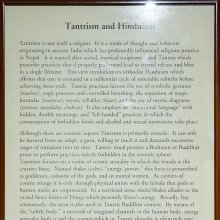
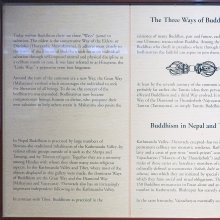
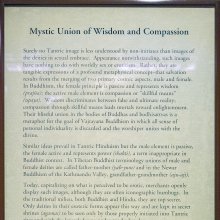
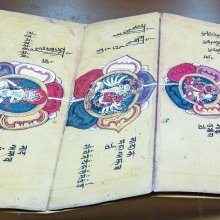
.jpg)
